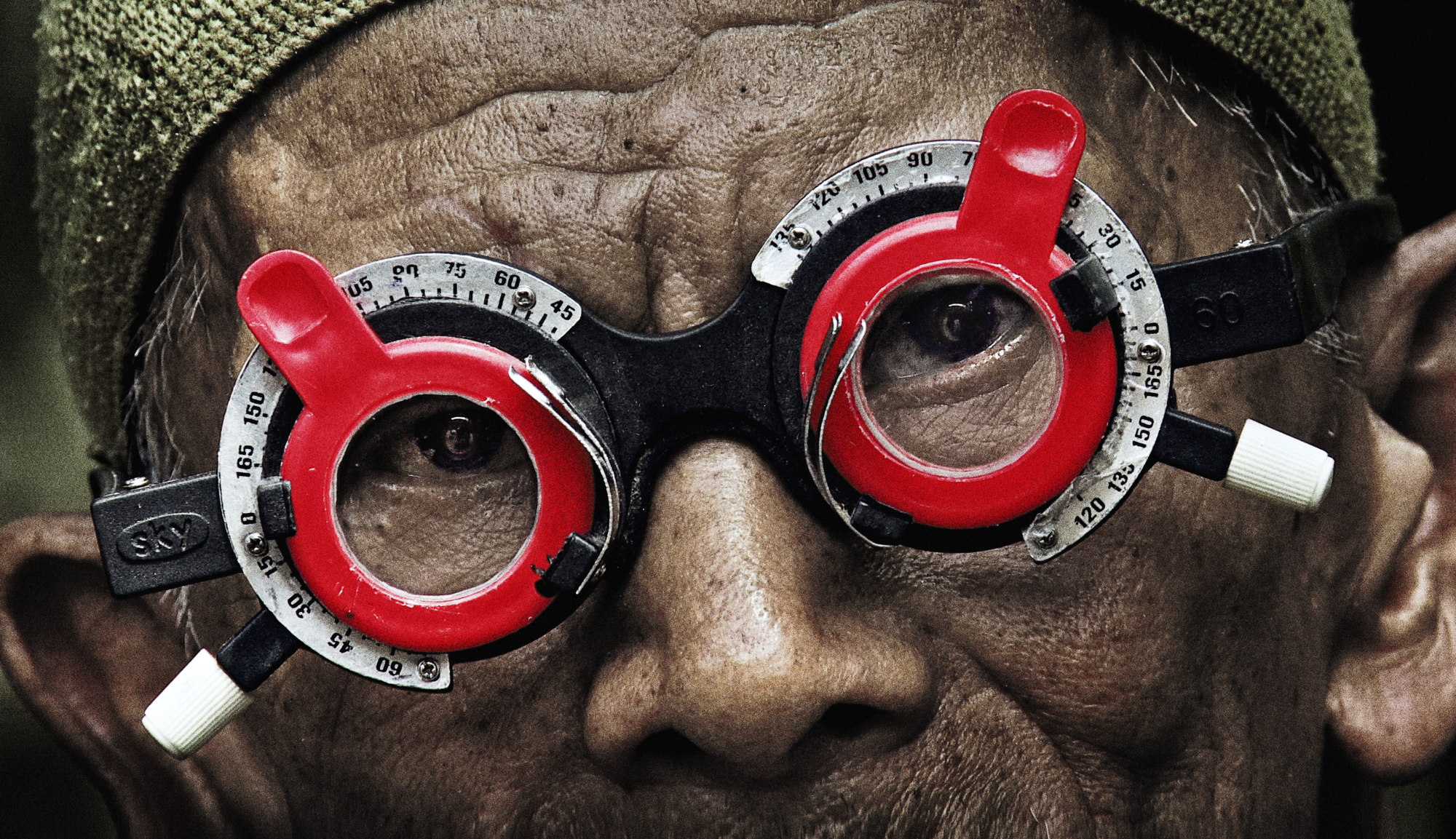There are two methods of evaluating the refractive error of an eye:
1. A subjective refraction where the result depends on the patient’s ability to discern changes in clarity. This process relies on the cooperation of the patient.[1]Andrew Franklin, ‘Subjective Refraction: Principles and Techniques for the Correction of Spherical Ametropia’, in Andrew Keirl & Caroline Christie (eds), Clinical Optics and Refraction: A Guide for Optometrists, Contact Lens Opticians and Dispensing Opticians, Elsevier, Philadelphia, 2007, p. 101.
Inong Sungai Ular, a frail septuagenarian, looks bizarre – even comical – in the thick black-and-red trial frame of The Look of Silence’s (Joshua Oppenheimer, 2014) opening scene. His eyes are vacant, slightly unfocused, and his near-toothless mouth ceaselessly twitches in an involuntary grimace. He asks his optician, Adi Rukun, for reading glasses. Sympathy would come easily for anyone seeing the old man, were it not for the conversation the two men have in his sunny Indonesian courtyard during the eye exam. ‘I know from experience, if you cut off a woman’s breast, it looks like a coconut milk filter: full of holes,’ he tells Adi, who holds his gaze in silence. After a moment he adds, ‘There was a communist woman.’
Ular was the leader of the village’s death squad, which, from 1965 to 1966, tortured, mutilated and murdered over 10,000 of the region’s suspected communists, among them farmers, intellectuals and those merely committing the crime of being ethnically Chinese. Their actions were sanctioned by the military, part of a nationwide massacre that claimed over 1 million lives in the name of exterminating communism in Indonesia.[2]Drafthouse Films & Participant Media, The Look of Silence press kit, 2014, pp. 12–5. The perpetrators have never been brought to justice, and indeed remain in positions of power throughout the country. It is a gruesome reality that Oppenheimer likens to ‘wander[ing] into Germany 40 years after the Holocaust, only to find the Nazis still in power’.[3]ibid., p. 5.
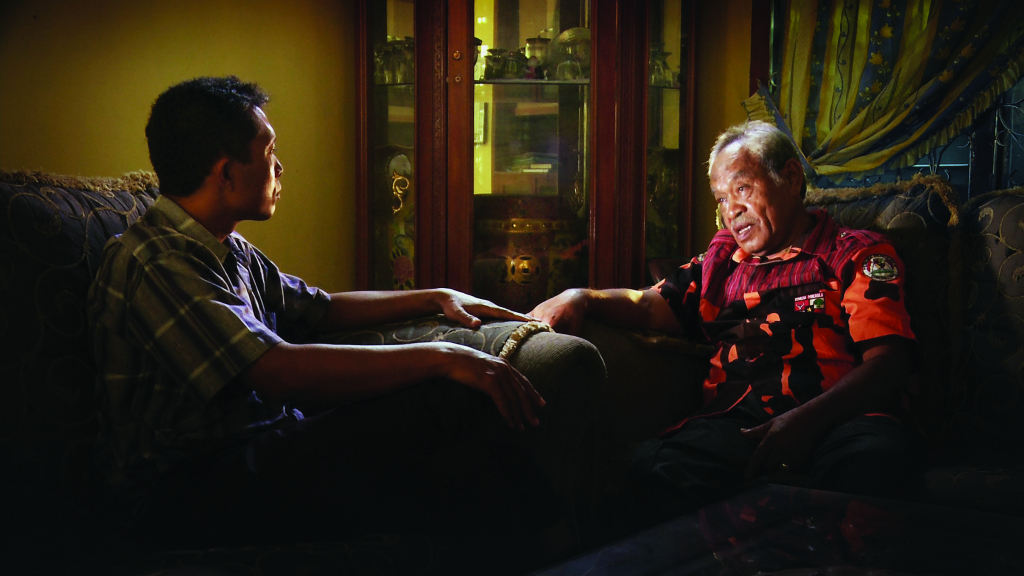
The Look of Silence is Oppenheimer’s second documentary exploring the 1965–1966 killings; his 2012 film, The Act of Killing, earned the director international acclaim. In it, he lets unrepentant mass murderers stage their memories of their gruesome acts in the style of their favourite movies. The result is a surreal vision of elderly men re-enacting their crimes as the heroes of the American Wild West or as film noir gangsters, culminating in an afterlife in which their victims thank them for relieving them of their sins. It is a portrait of a country intoxicated by nearly five decades of propaganda, although the cracks of neurosis splinter the image of national contentment at every turn. The Look of Silence acts as a companion piece to this earlier documentary. Whereas The Act of Killing deals in make-believe and wilful distortion, The Look of Silence teases the killers out into bright daylight and brings them under the scrutiny of one of their victims.
The questioning technique is very important throughout subjective refraction because the use of appropriately phrased questions can make the difference between a quick, precise refraction and a long-winded, potentially inaccurate refraction.[4]Franklin, op. cit., p. 102.
The suitcase filled with hundreds of carefully sorted trial lenses and the thick trial frame is at the centre of Adi’s business. He carries it to each of his patients’ houses, fitting them for their prescriptions while chatting about their lives. Normally, he might natter about mundane topics – the birth of a grandchild, the marriage of a relative, the state of the weather – but meeting Oppenheimer in 2003 gave him the chance to do what previously would have been unthinkable: to confront the men who destroyed his family.
Adi wasn’t even born when the genocide took place, but he spent his life dealing with its reverberations. Two years before his birth, his brother Ramli was mutilated and murdered, and his family marked as communist sympathisers. Adi grew up in his brother’s shadow (his mother, Rohani, calls him ‘the answer to [her] prayers’, considering him a divine replacement for her murdered child), and spent a lifetime seeing his parents extorted by still-powerful perpetrators, his children brainwashed by teachers’ propaganda, and his neighbours too terrified to speak of what was done to them. He witnessed his frail father descend into senility, losing all memory of his dead son and the ability to contextualise his ingrained fear, leaving nothing but a prison of disoriented terror. There was nothing he could do.
The resultant film casts Adi in the role of guide through a community of victims and perpetrators who have wilfully blinded themselves to their shared past, his optician’s tools transformed into powerful metaphors for the seeds of clarity he seeks to plant in his neighbours.
Oppenheimer and Adi initially met when the director was in the early stages of his research into the murders, and they quickly became close friends. Adi spent years watching Oppenheimer’s raw footage of swaggering killers recounting their deeds, and urged him on during the making of The Act of Killing. For a long time, the two men brainstormed ways to approach a second movie, which would chronicle the lives of the victims forced to live among their aggressors. Adi desired to meet the men who killed his brother, to reach through their facade of boastfulness and offer them a way back to reality by granting forgiveness. Oppenheimer refused – it was far too dangerous.[5]Drafthouse Films & Participant Media, op. cit., p. 6.
Then, in 2012, after the editing of The Act of Killing but before its release, they found themselves in a unique situation, as Oppenheimer recalls:
[T]he shooting of The Act of Killing was famous across North Sumatra, but nobody had seen it yet. I was therefore well known across the region for having worked closely with the most powerful perpetrators in the country – the Vice President, cabinet ministers, the national head of the paramilitary organisation. The men Adi hoped to confront were regionally but not nationally powerful. They would think I am close to their superiors, and would not want to offend them by physically attacking us or even detaining us.[6]ibid, p. 7.
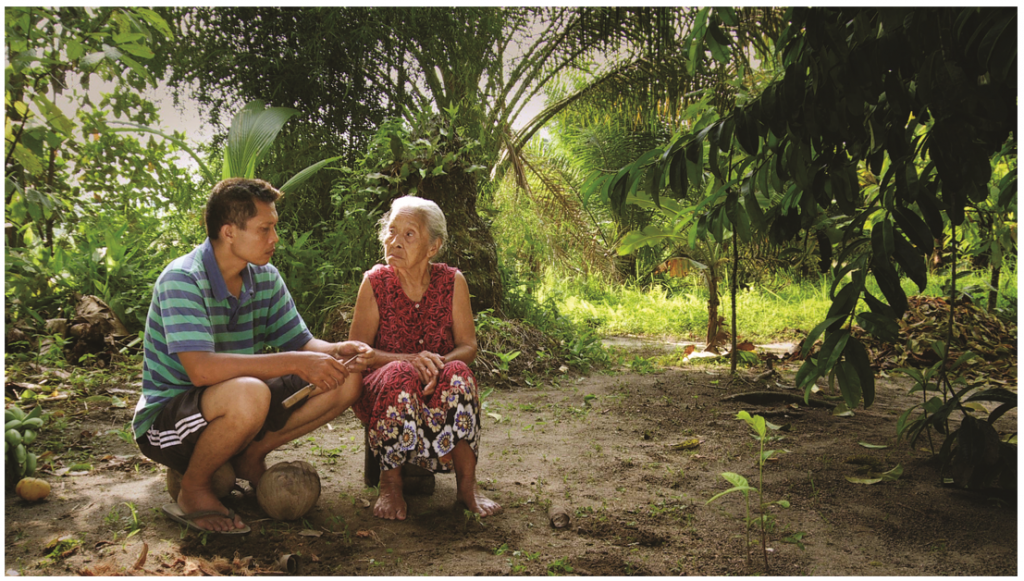
They decided to take the risk, and offered willing interviewees free eye exams and a pair of glasses as added incentives, as well as to diffuse a naturally tense situation. The resultant film casts Adi in the role of guide through a community of victims and perpetrators who have wilfully blinded themselves to their shared past, his optician’s tools transformed into powerful metaphors for the seeds of clarity he seeks to plant in his neighbours.
The ability to discriminate and communicate will of course vary widely from person to person but, in general, the simpler the task, the more likely it will be performed well.[7]Franklin, op. cit., p. 102.
The scene that inspired Oppenheimer to make his two films took place by the banks of North Sumatra’s Snake River in January 2004. He had been invited by two of the death-squad leaders to visit the site at which they killed over 10,000 people, among them Adi’s brother. The footage, which we see Adi watch on his television in The Look of Silence, shows the two men carrying on as though attending, say, a family barbecue – even taking a souvenir snapshot at the clearing where they used to dump beheaded bodies into the water. Of the day, which he refers to as ‘one of the most traumatic of [his] life’, Oppenheimer recounts that
what terrified me was the fact that the two men had never met before, yet seemed to be reading from a shared script […] I realised that the boasting was systemic.[8]Drafthouse Films & Participant Media, op. cit., p. 2.
As Adi speaks to person after person, the same scripts appear to emerge: perpetrators initially brag about their actions and then, when pressed for deeper engagement, reject all responsibility – they were just following orders, powerless in the face of hierarchy, defending their country and families from depraved and dangerous people. It was just politics. In their defence, they rattle off well-worn lies: the communists had no faith, no morals; they asked to be killed.
The victims and bystanders follow their own carefully rehearsed scripts. It is not their right to question or seek revenge; they believe God will bring justice to those who have wronged them. Their wounds have healed; there is no use in causing trouble. One woman, when asked what her village was like in 1965, immediately says, ‘Nothing happened. It was calm.’ When Adi mentions Snake River, she says, ‘Oh, you mean communists. I know nothing about it,’ before describing them being blindfolded, marched to the river and shot; she then complains, ‘You ask too many questions.’ Both victims and perpetrators agree, again and again: the past is the past and ought to be left alone.
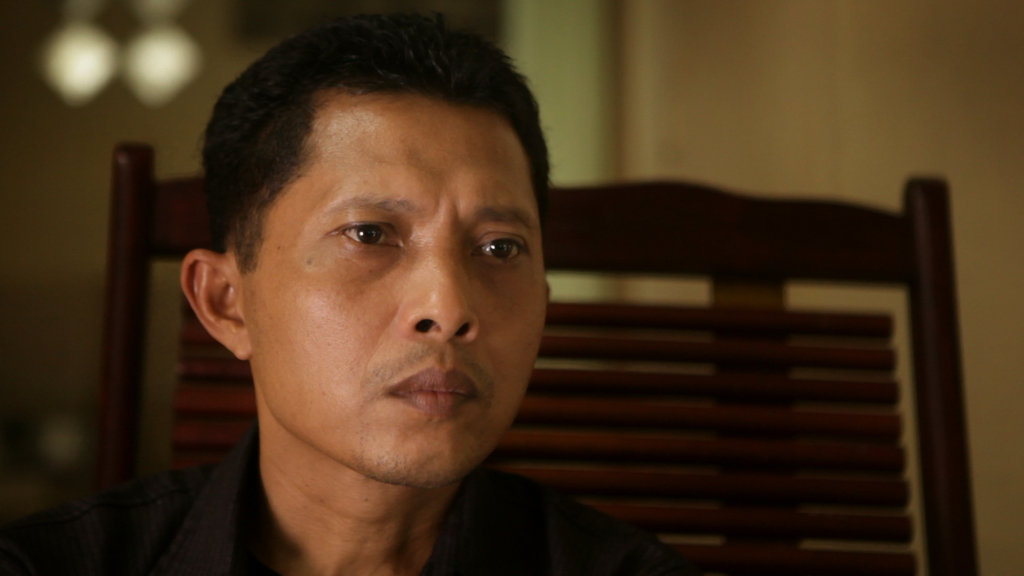
There is a sense of heaviness in each interviewee, though – an invisible weight that lives in melancholy stares into emptiness and in the long-drawn silences filled only by the chirping of insects. It’s present in Adi’s crippled, blind 103-year-old father, who barely remembers his family. It’s in the twitching eyes and mouth of Ular, who cut off Ramli’s genitals and watched as he bled out – who is grateful he drank two glasses of his victims’ blood every day, as this has kept insanity at bay. It’s in the hunched-over shoulders and furrowed brows of Adi’s teenage son, who is troubled by the conflicting stories he is told by his trusted schoolteacher and his own father. It is in Adi himself as he watches scene after scene of Oppenheimer’s testimonies about the killers on his television set, alone and lost in thought. Within this community weighed by constant, silent shock, only Adi’s young daughter Aisyah, a veritable firecracker of a girl, stands out. She can lose herself in fits of giggles and delighted shrieks while playing with her father’s optical equipment, farting during story time or claiming she hasn’t brushed her teeth in at least a year. The weight of the dead does not yet rest on her.
There is a sense of heaviness in each interviewee, though – an invisible weight that lives in melancholy stares into emptiness and in the long-drawn silences filled only by the chirping of insects.
Jumping beans are a key recurring image in the movie: dark, hard objects sent twitching by an unseen, blind force within. Aisyah claims there are butterflies inside them. Perhaps she knows this because she, too, is a kind of butterfly imprisoned in a dark, hard shell – a colourful spirit unburdened by the pain of her country’s past, twitching to break out of her prison and thrive, if only a crack could manifest in the oppressive shell of silence. The last scene of the film is of Rohani, speaking to jumping beans in the palm of her hand: ‘I can’t see you. Are you there? I want to see you. Come out.’
When negative lenses are required care must be taken not to over-minus the patient […] The question required when adding negative power should be altered to: Is the target clearer or just darker with this lens?[9]Franklin, op. cit., p. 103.
It’s his wish for a better, more open future for his children that drives Adi first and foremost. ‘I do not want [them] to inherit this prison of fear from my father, my mother, and from me,’[10]Adi Rukun, quoted in Drafthouse Films & Participant Media, op. cit., p. 7. he told Oppenheimer when they first discussed the possibility of confronting Ramli’s killers. But what if his neighbours are right – what if the past is best left undisturbed?
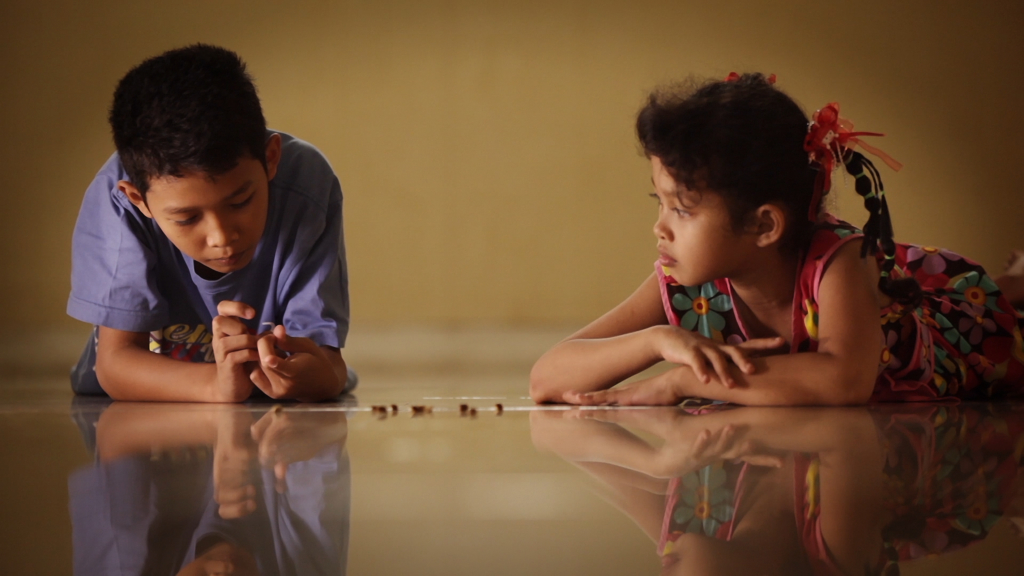
When Adi tells his wife and mother what he has been doing, they react with great concern. What if something were to happen to him? Had he thought of what his wife and children might do? He should leave it, or at least be very careful. ‘Just bring a butterfly knife. Or a club wrapped in newspaper,’ Rohani tells her son, ‘If they try anything, hit them in the back of the head. Right here. They won’t get back up again.’ Their concern is not unwarranted. When Adi refuses to let Amir Siahaan, the commander of the Snake River death squads, deny his moral responsibility for ordering the deaths of over 10,000 people and building a life of wealth and comfort upon it, the old man changes the subject. ‘Adi, where did your brother live?’ he asks. ‘In which village? […] What subdistrict? Just tell me. It’s okay.’ Adi, whose demeanour towards his interview subjects is always exceptionally poised, swallows his nerves and politely refuses any information. He is visibly affected, but stands his ground. ‘These days […] the known communists aren’t dangerous,’ Siahaan muses. ‘It’s the secret ones who are dangerous. Maybe what you’re doing now is a secret communist activity.’
A similar confrontation occurs when Adi speaks to MY Basrun, the speaker of the regional legislature. Upon learning that Adi is a victim’s family member, Basrun sighs. ‘If you keep making an issue of the past, it will definitely happen again,’ he says.
There are two methods of evaluating the refractive error of an eye:
[…]
2. An objective refraction (usually retinoscopy) where the result depends purely on the examiner’s judgement to determine the optimum optical correction.[11]Franklin, op. cit., p. 101.
From the outset, Oppenheimer doubted Adi would inspire Ramli’s killers to feel remorse, but he hoped that, together, they might achieve something far more important:
I felt that if I could show why the perpetrators cannot apologize, if I could film with precision and intimacy their complex, human reactions to being visited by their victim’s brother, then perhaps I could make visible the abyss of fear, guilt, and (for the perpetrators) fear of their own guilt that divides every Indonesian from each other, and from their own past – and thus from themselves.[12]Drafthouse Films & Participant Media, op. cit., p. 7 (emphasis in original).
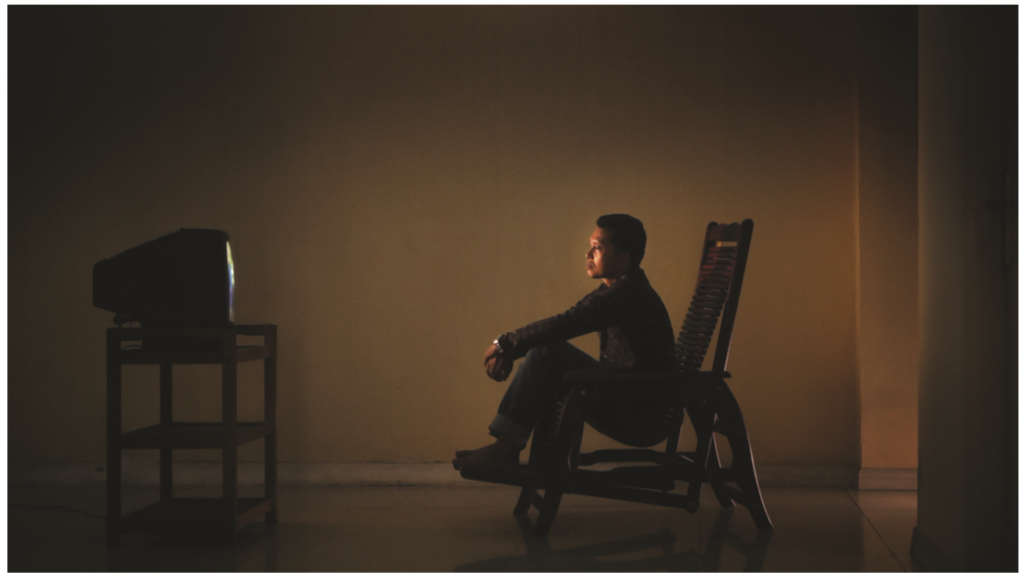
In the end, the personal feelings of the killers are of little consequence. They are old men now, some nearly toothless and hunched over by hardship, others made comfortable by riches amassed from slaughter. But they are all ageing, and dying.
It is their children and grandchildren, the next generation of Indonesians, like Adi’s daughter Aisyah, who count. It is still too early to determine the impact The Look of Silence will have on Indonesia’s people, but its forerunner has already claimed significant milestones on the path to reconciliation and the end of secrecy. As a direct result of The Act of Killing, the facade of propaganda has begun to crack. National news media, for the first time in five decades, are able to question their government’s actions and press for change.[13]ibid., pp. 9–10. Whereas the initial public screenings of The Act of Killing were held in secret, The Look of Silence premiered in Indonesia’s largest movie theatre, hosted by two Indonesian government agencies. Tens of thousands of people have seen the film since, through thousands of public screenings. Adi’s most fundamental goal, to break through the veil of silence, has been achieved.
Despite its significant impact, however, The Look of Silence has not been spared from backlash. Police began shutting down screenings ‘to prevent violence’ by thugs and dissidents, most probably organised by the military or police force themselves. Shortly after, the Indonesian censorship office banned the film in East Java, a decision that continues to be protested by Indonesia’s media and many citizens, who argue it ‘sets a disturbing precedent’[14]Jess Melvin, ‘LSF Moves to Silence Senyap’, The Jakarta Post, 10 January 2015, <http://thejakartapost.com/news/2015/01/10/lsf-moves-silence-senyap.html>, accessed 15 August 2015. and may foreshadow future national bans. Adi and his family even received threatening visits from local killers and the military, and were forced to relocate to another part of the country.[15]Karen Attwood, ‘Adi Rukun Interview: The Subject of a Haunting New Documentary on Meeting His Brother’s Killers’, ‘True Life Fund’, True/False, 13 June 2015, <http://www.independent.co.uk/arts-entertainment/films/features/adi-rukun-interview-the-subject-of-a-haunting-new-documentary-on-meeting-his-brothers-killers-10318189.html>, accessed 6 August 2015. Yet his bravery has not gone unrewarded – earlier this year, his family was awarded US$35,000 in donations through the True Life Fund, an initiative set up by the True/False film festival to provide
tangible assistance to the real-life subjects of a new non-fiction film. It acknowledges that documentary filmmakers and festivals thrive because of the stories given to us by people often of limited means.[16]‘True Life Fund’, True/False website, <http://truefalse.org/program/true-life-fund>, accessed 6 August 2015.
The money will help Adi set up a permanent optometrist’s shop and lift his family out of poverty created by five decades of economic suppression.
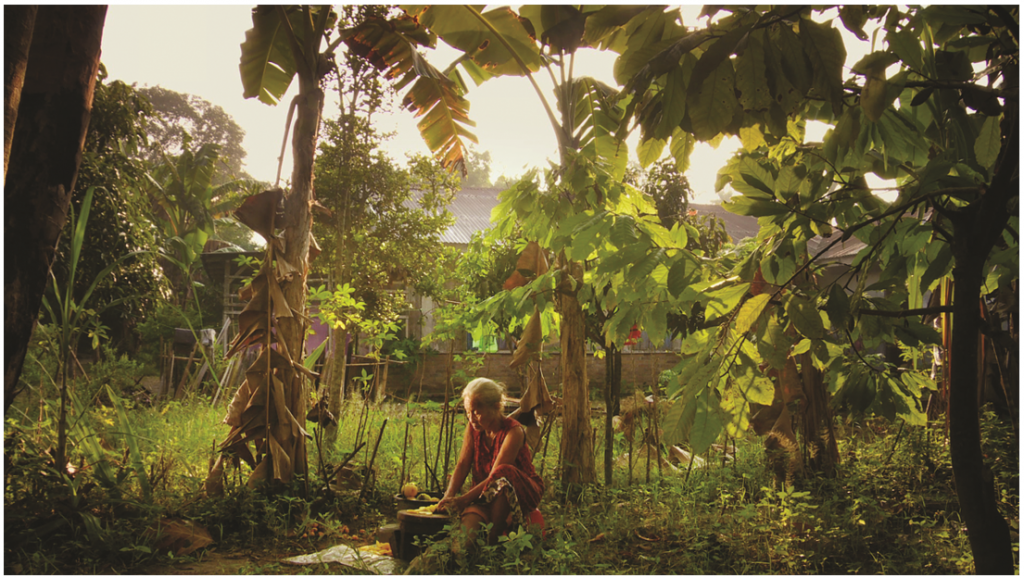
The greatest reward for Adi’s and Oppenheimer’s efforts happened long before the film’s release, however, and can be witnessed on screen. One day, Adi interviews a former death-squad member and his adult daughter. She tells Adi of the pride she felt growing up, knowing her father was respected as an exterminator of communists. But then something changes. For the first time, she hears her father actually describe the acts he committed, taking a Chinese woman’s head into a cafe just to scare the customers, and drinking his victims’ blood. The face of the killer’s daughter transforms, her eyes cloud over in an expression remarkably similar to the one Adi himself wears when watching confessions on his television set. Adi turns away from the old man and begins addressing her directly, letting her express her terror at her father’s confession and revealing his own family link to the massacres. When the old man gets uncomfortable, protesting that it is getting late, his words are no longer relevant, drowned out by a room filled with the silence of a deeply felt shared experience. The woman gives Adi the only genuine apology of the film. ‘It is not your fault that your father is a murderer,’ Adi then tells her while holding back tears. ‘Whatever he is, he is still your father.’
Among this family, Adi has achieved what he set out to do: by refusing to adhere to accepted scripts, he dragged the killer out of the shadows and put his sadistic actions into sharp focus, allowing his daughter to see him clearly. Instead of retreating into defensiveness, she reacts with compassion – and, perhaps for the first time since the massacres, the sides of victim and perpetrator truly see one another. Brushing off her father’s continued protests, the woman looks up and says, ‘I feel I know you. Have we met before?’ Adi responds that he feels he knows her, too, and she laughs. ‘We know each other now. We’re like family.’ Their embrace is awkward, but sincere.
http://www.thelookofsilence.com
Endnotes
| 1 | Andrew Franklin, ‘Subjective Refraction: Principles and Techniques for the Correction of Spherical Ametropia’, in Andrew Keirl & Caroline Christie (eds), Clinical Optics and Refraction: A Guide for Optometrists, Contact Lens Opticians and Dispensing Opticians, Elsevier, Philadelphia, 2007, p. 101. |
|---|---|
| 2 | Drafthouse Films & Participant Media, The Look of Silence press kit, 2014, pp. 12–5. |
| 3 | ibid., p. 5. |
| 4 | Franklin, op. cit., p. 102. |
| 5 | Drafthouse Films & Participant Media, op. cit., p. 6. |
| 6 | ibid, p. 7. |
| 7 | Franklin, op. cit., p. 102. |
| 8 | Drafthouse Films & Participant Media, op. cit., p. 2. |
| 9 | Franklin, op. cit., p. 103. |
| 10 | Adi Rukun, quoted in Drafthouse Films & Participant Media, op. cit., p. 7. |
| 11 | Franklin, op. cit., p. 101. |
| 12 | Drafthouse Films & Participant Media, op. cit., p. 7 (emphasis in original). |
| 13 | ibid., pp. 9–10. |
| 14 | Jess Melvin, ‘LSF Moves to Silence Senyap’, The Jakarta Post, 10 January 2015, <http://thejakartapost.com/news/2015/01/10/lsf-moves-silence-senyap.html>, accessed 15 August 2015. |
| 15 | Karen Attwood, ‘Adi Rukun Interview: The Subject of a Haunting New Documentary on Meeting His Brother’s Killers’, ‘True Life Fund’, True/False, 13 June 2015, <http://www.independent.co.uk/arts-entertainment/films/features/adi-rukun-interview-the-subject-of-a-haunting-new-documentary-on-meeting-his-brothers-killers-10318189.html>, accessed 6 August 2015. |
| 16 | ‘True Life Fund’, True/False website, <http://truefalse.org/program/true-life-fund>, accessed 6 August 2015. |
